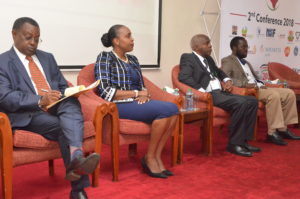Did you know that counties have the mandate to initiate, expand and implement social health insurance programs in-line with the Constitution and the Kenya Vision 2030?
As Kenya, continues making strides towards promoting UHC, at least 3.2 million Kenyans in four counties will be the first beneficiaries of a new health package being developed by the Government. The health benefit package, under the Universal Health Coverage programme beneficiaries will come from Kisumu, Isiolo, Nyeri and Machakos counties.

According to the Cabinet Secretary for Health, Mrs. Sicily Kariuki, piloting the package in a controlled population ensures less chances of failure and risks can be minimized when the programme is eventually scaled up to the whole population. The decision to pilot the programme in these counties was evidence-based on disease burden in the significant areas and can be summarised as follows:
- For Kisumu, it is because it leads in the high number of infectious diseases like HIV/AIDS and tuberculosis;
- Machakos hospital visits are mostly because of accidents and injuries;
- Nyeri is leading in cases of non-communicable diseases, particularly diabetes; and
- Isiolo is ideally meant to assess how the package will work among the nomadic population.
Piloting the health coverage program is key because the health sector is working on identifying an operational approach that enables the rapid expansion of coverage for delivering an essential package of quality basic health services that is both fiscally sustainable and consistent with Kenya’s governance structure. Having an official policy on Universal Health Care will provide a clear mandate on the goals, targets and monitoring and evaluation of performance.
Universal Health Coverage is more than just eliminating the out-of-pocket expenditure; it is also about ensuring access to quality health care. This means that capacity in both structural and resource must be increased to handle the needs of the population. Additionally, there needs to be continuous awareness towards getting persons registered for the various health care programs and campaigns used to encourage registration prior to one getting sick. While expanding the NHIF cover is good, there is a need for the County Governments to work with the National Government to outline a plan that creates a seamless process and spectrum of cover at every level of care providing the necessary resources at any given time. There also needs to be lateral cooperation across counties and uniformity when designing various county health programs and schemes (within framework of the national plan).
For starters, Makueni County, through Makueni Care, has been successful in offering its people free healthcare across all its public facilities and sub-county hospitals. This was implemented after realization that 40% of its people would sell their land and exhaust family income to pay for medical bills for relatives. For an annual subscription of Kshs. 500 per household covering parents and all their children under the age of 18 years or up to 24 years incase they are students, Makueni Care has managed to offer free across the board healthcare to its residents eliminating user fees sub-county hospitals would collect.
Dr. Andrew Mutava Mulwa, the County Minister of Health, estimates that Makueni Care covers at least 93 per cent of the county’s healthcare needs. The cover he says is built on a platform of ensuring adequate provision of primary care by increasing facilities, improving services and ensuring that medicines are available. This in turn ensures that most locals are treated within the local health dispensaries as opposed to secondary or tertiary referral facilities.
Kitui County is also on track to providing its residents with access to subsidized healthcare. Known as the Kitui County Health Insurance Cover (K-CHIC), the recently launched programme will ensure that more than 270,000 households in Kitui access high quality medical services including curative, promotive, preventive, rehabilitative and specialised services within all county public health facilities.
In order to attain our aspirations within the Kenya Vision 2030, it is vital that all counties should focus on creating partnerships with the Private Sector, NGOs and Civil Society groups so as to increase funding and sustain some of the health programs that will aid in achieving the Social Pillar. This will go a long way in providing the health system with infrastructure, medical equipment, research and development and capacity building and training through which the National Government can directly collaborate with each County Government thereby touching each and every Kenyan.
